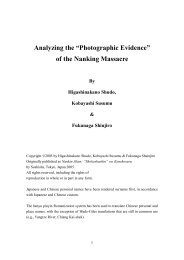TOP-SECRET CHINESE NATIONALIST DOCUMENTS REVEAL ...
TOP-SECRET CHINESE NATIONALIST DOCUMENTS REVEAL ...
TOP-SECRET CHINESE NATIONALIST DOCUMENTS REVEAL ...
Create successful ePaper yourself
Turn your PDF publications into a flip-book with our unique Google optimized e-Paper software.
<strong>TOP</strong>-<strong>SECRET</strong> <strong>CHINESE</strong> <strong>NATIONALIST</strong> <strong>DOCUMENTS</strong> <strong>REVEAL</strong> THE TRUTH ABOUT<br />
THE NANKING INCIDENT<br />
(Summary)<br />
Higashinakano Shudo<br />
Professor of Intellectual History<br />
Asia University, Tokyo<br />
In January 2003, official documents that demolish — once and for all — the “Nanking<br />
Massacre” myth were discovered. Marked “top-secret,” they were compiled in 1941 by the<br />
Chinese Nationalist Ministry of Information under the title Outline of International Propaganda<br />
Operations. The documents are detailed records describing counterintelligence activities<br />
implemented by the Nationalists in 1937, when war with Japan broke out, and thereafter.<br />
Nanking was the seat of Chiang Kai-shek’s Nationalist government in 1937. The documents are<br />
preserved in Taiwan, home to the Nationalists since 1949. The author discovered them at the<br />
Museum of Chinese Nationalist Party History in Taipei. He made photocopies of the documents,<br />
which he took back to Japan.<br />
An examination of those documents reveals that the provenance of accusations that Japan<br />
perpetrated a massacre in Nanking is wartime propaganda initiated by the Nationalist intelligence<br />
organization. They also expose European and American Nationalist agents who were intimately<br />
involved in the concoction of “Nanking Massacre” propaganda.<br />
One of them was the China correspondent for the Manchester Guardian, an Australian who went<br />
by the name of H. J. Timperley. At the time, Timperley was perceived as the conscientious<br />
journalist who told the world about the “Nanking Massacre.” What War Means: The Japanese<br />
Terror in China, a book that he edited, became the bible of proponents of the massacre. However,<br />
the top-secret documents unearthed in 2003 state, in no uncertain terms, that What War Means<br />
was part of the Chinese propaganda campaign against Japan.<br />
In 1937, the Nationalist government’s International Propaganda Department made the decision to<br />
mount an external propaganda campaign involving foreign (European and American)<br />
collaborators. The use of foreign newspaper reporters as those collaborators was central to that<br />
campaign.<br />
The International Committee for the Nanking Safety Zone was organized mainly by Christian<br />
missionaries from the U.S.; its members were all foreigners residing in Nanking. We now know<br />
that the Committee’s leaders were closely connected with Timperley, and participated willingly<br />
in the propaganda campaign against Japan. War Damage in the Nanking Area, written by Lewis<br />
Smythe and M. S. Bates, was also a Chinese Nationalist propaganda tool designed for use against<br />
Japan.<br />
Equally important, perhaps, is absence of any mention of a massacre’s having been perpetrated in<br />
Nanking in official Nationalist government proclamations issued between 1937 and 1945. In the
aforementioned top-secret documents, no particular emphasis is given to Nanking in the year<br />
1937, except for references to the launching of a propaganda war against Japan in connection<br />
with the fall of the Nationalist capital.<br />
According to these same documents, between December 1937 (the time when the massacre is<br />
supposed to have been committed) and October 1938, the Nationalist government, now operating<br />
from Hankou, held a total of 300 press conferences to which members of the foreign press were<br />
invited (usually 50 of those journalists attended). However, there is no evidence showing that<br />
mention of a massacre in Nanking was made at any of those conferences. The government did<br />
issue a protest to the Assembly of the League of Nations soon after the Nanking Incident (the fall<br />
of Nanking). However, that protest was in connection with a minor bombing incident in Hankou.<br />
Even more interesting are the circumstances surrounding the Chinese translation of What War<br />
Means: The Japanese Terror in China, the aforementioned propaganda book issued by the<br />
International Propaganda Department. Outline of International Propaganda Operations tells us<br />
that portions of the book suggesting that there had been a massacre in Nanking were deleted from<br />
that translation. The International Propaganda Department had apparently deemed those sections<br />
inappropriate because they lacked credibility and might be counterproductive. This decision<br />
implies that the Nationalist propaganda machine had determined that the dissemination of<br />
propaganda — even in wartime — relating to a massacre in Nanking was unseemly.<br />
Proponents of the “Nanking Massacre” have been mystified for decades by the absence of<br />
references to a massacre in the writings of Chiang Kai-shek and Mao Zedong, and in reports and<br />
other documents relating to the Battle of Nanking issued by the Nationalist government. Outline<br />
of International Propaganda Operations has solved the mystery, once and for all.












